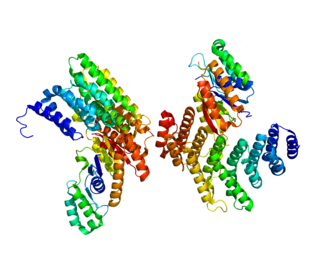
Structural maintenance of chromosomes protein 3 (SMC3) is a protein that in humans is encoded by the SMC3 gene. SMC3 is a subunit of the Cohesin complex which mediates sister chromatid cohesion, homologous recombination and DNA looping. Cohesin is formed of SMC3, SMC1, RAD21 and either SA1 or SA2. In humans, SMC3 is present in all cohesin complexes whereas there are multiple paralogs for the other subunits.

Whirlin is a protein that in humans is encoded by the DFNB31 gene.

Symplekin is a protein that in humans is encoded by the SYMPK gene.

Ubiquitin-associated protein 1 is a protein that in humans is encoded by the UBAP1 gene.

AT-rich interactive domain-containing protein 2 (ARID2) is a protein that in humans is encoded by the ARID2 gene.

Sorting nexin-5 is a protein that in humans is encoded by the SNX5 gene.

Shugoshin 2(Shugoshin-2), also known as Shugoshin-like 2, is a protein which in humans is encoded by the SGO2 gene.

DOP1B is a human gene located just above the Down Syndrome chromosomal region (DSCR) located at 21p22.2 sub-band. Although the exact function of this gene is not yet fully understood, it has been proven to play a role in multiple biological processes, and its over-expression (triplication) has been linked to multiple facets of the Down Syndrome phenotype, most notably mental retardation.

DEAD (Asp-Glu-Ala-Asp) box polypeptide 27, also known as DDX27, is a human gene.

snRNA-activating protein complex subunit 4 is a protein that in humans is encoded by the SNAPC4 gene.

TBC1 domain family member 10A is a protein that in humans is encoded by the TBC1D10A gene.

General transcription factor 3C polypeptide 5 is a protein that in humans is encoded by the GTF3C5 gene.

SLC35F6 is a protein that in humans is encoded by the SLC35F6 gene. The orthologue in mice is 4930471M23Rik.

Meckel syndrome, type 1 also known as MKS1 is a protein that in humans is encoded by the MKS1 gene.

Integrator complex subunit 12 (Int12) also known as PHD finger protein 22 (PHF22) is a protein that in humans is encoded by the INTS12 gene.

WD repeat domain 47 is a protein that in humans is encoded by the WDR47 gene.

RNA polymerase II associated protein 2, also known as RPAP2, is a human gene.

Nucleolar protein with MIF4G domain 1 is a protein that in humans is encoded by the NOM1 gene.

DIP2 disco-interacting protein 2 homolog B (Drosophila) is a protein that in humans is encoded by the DIP2B gene. A member of the disco-interacting protein homolog 2 protein family, it contains a binding site for the transcriptional regulator DNA methyltransferase 1 associated protein 1, as well as AMP-binding sites. The presence of these sites suggests that DIP2B may participate in DNA methylation. This gene is located near a folate-sensitive fragile site.

BPI fold containing family A, member 3 (BPIFA3) is a protein that in humans is encoded by the BPIFA3 gene. The gene is also known as SPLUNC3 and C20orf71 in humans and the orthologous gene in mice is 1700058C13Rik. There are multiple variants of the BPIFA3 projected to be a secreted protein. It is very highly expressed in testis with little or no expression in other tissues. The Human Protein Atlas project and Mouse ENCODE Consortium report RNA-Seq expression at RPKM levels of 29.1 for human testis and 69.4 for mouse, but 0 for all other tissues. Similarly, the Bgee consortium, using multiple techniques in addition to RNA-Seq, reports a relative Expression Score of 95.8 out of 100 for testis and 99.0 for sperm in humans; however low levels of BPIFA3 between 20 and 30 were seen for a variety of tissues such as muscle, glands, prostate, nervous system, and skin.

















